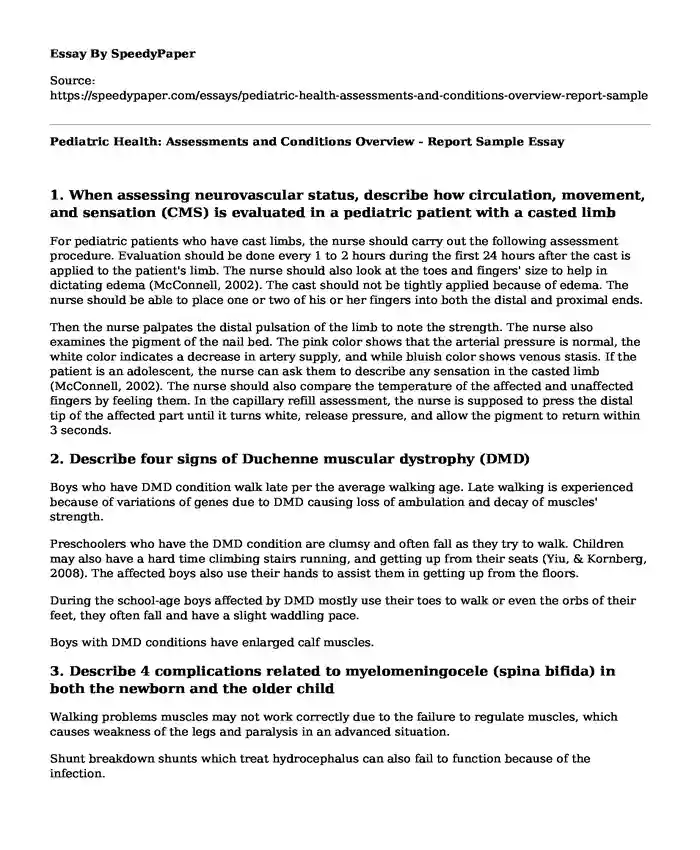
| Type of paper: | Essay |
| Categories: | Health and Social Care Childhood |
| Pages: | 3 |
| Wordcount: | 664 words |
1. When assessing neurovascular status, describe how circulation, movement, and sensation (CMS) is evaluated in a pediatric patient with a casted limb
For pediatric patients who have cast limbs, the nurse should carry out the following assessment procedure. Evaluation should be done every 1 to 2 hours during the first 24 hours after the cast is applied to the patient's limb. The nurse should also look at the toes and fingers' size to help in dictating edema (McConnell, 2002). The cast should not be tightly applied because of edema. The nurse should be able to place one or two of his or her fingers into both the distal and proximal ends.
Then the nurse palpates the distal pulsation of the limb to note the strength. The nurse also examines the pigment of the nail bed. The pink color shows that the arterial pressure is normal, the white color indicates a decrease in artery supply, and while bluish color shows venous stasis. If the patient is an adolescent, the nurse can ask them to describe any sensation in the casted limb (McConnell, 2002). The nurse should also compare the temperature of the affected and unaffected fingers by feeling them. In the capillary refill assessment, the nurse is supposed to press the distal tip of the affected part until it turns white, release pressure, and allow the pigment to return within 3 seconds.
2. Describe four signs of Duchenne muscular dystrophy (DMD)
Boys who have DMD condition walk late per the average walking age. Late walking is experienced because of variations of genes due to DMD causing loss of ambulation and decay of muscles' strength.
Preschoolers who have the DMD condition are clumsy and often fall as they try to walk. Children may also have a hard time climbing stairs running, and getting up from their seats (Yiu, & Kornberg, 2008). The affected boys also use their hands to assist them in getting up from the floors.
During the school-age boys affected by DMD mostly use their toes to walk or even the orbs of their feet, they often fall and have a slight waddling pace.
Boys with DMD conditions have enlarged calf muscles.
3. Describe 4 complications related to myelomeningocele (spina bifida) in both the newborn and the older child
Walking problems muscles may not work correctly due to the failure to regulate muscles, which causes weakness of the legs and paralysis in an advanced situation.
Shunt breakdown shunts which treat hydrocephalus can also fail to function because of the infection.
Accretion of liquid in the brain- newborns infected by myelomeningocele has their brains filled with fluid due to the infection.
Problems associated with urine, bladder, and bowel (Lorber, 1973). When the nerves that supply the bladder and bowel are affected, the baby develops problems with the bowel and bladder.
4. Briefly describe the pathophysiology of cerebral palsy (CP) and broadly describe CP's clinical manifestation.
The disordered physiological processes that are associated with cerebral palsy include the following. The preterm newborn's brain is inclined with periventricular leukomalacia (PVL) and intraventricular hemorrhage (IVH) pathologies (Longo, & Hankins, 2009).IVH explains bleeding that occurs in the brain's ventricles from the origin of the brain cells, which is called subependymal.IVH is also a risk aspect of PVL. The clinical manifestation associated with CP includes a deficiency of independent sitting at the age of 8 months after birth, a symbol of abnormal motor development.
References
Longo, M., & Hankins, G. D. (2009). Defining cerebral palsy: pathogenesis, pathophysiology, and new intervention. Minerva ginecologica, 61(5), 421. https://www.ncbi.nlm.nih.gov/pubmed/19749673
Lorber, J. (1973). Early results of selective treatment of spina bifida cystic. Br Med J, 4(5886), 201-204. https://link.springer.com/content/pdf/10.1007/978-88-470-0651-5.pdf
McConnell, E. A. (2002). Assessing neurovascular status in a casted limb. Nursing2019, 32(9), 20. https://journals.lww.com/nursing/Fulltext/2002/09000/Assessing_neurovascular_status_in_a_casted_limb.13.aspx
Yiu, E. M., & Kornberg, A. J. (2008). Duchenne muscular dystrophy. Neurology India, 56(3), 236. http://www.neurologyindia.com/article.asp?issn=0028-3886;year=2008;volume=56;issue=3;spage=236;epage=247;aulast=yiu
Cite this page
Pediatric Health: Assessments and Conditions Overview - Report Sample. (2024, Jan 07). Retrieved from https://speedypaper.com/essays/pediatric-health-assessments-and-conditions-overview-report-sample
Request Removal
If you are the original author of this essay and no longer wish to have it published on the SpeedyPaper website, please click below to request its removal:
- Free Essay Example: Analysis of the Persuasiveness of Passage
- Essay Sample on The Unlicensed Assistive Personnel
- Paper on Ensuring Safety for Healthcare Workers Amidst the COVID-19 Pandemic: A Call to Support OSHA
- Essay on Treating Loneliness in Nursing Residents: 7 Sept 2020
- Bob: The Travel Nurse Who Assists All Patients- Essay Sample
- Paper on Unveiling Diabetes Education in Anguilla: A Comprehensive Analysis of Data Collection and Insights
- Addressing World Hunger: Causes, Inequality, and the Role of Mercy Corps - Essay Sample
Popular categories




